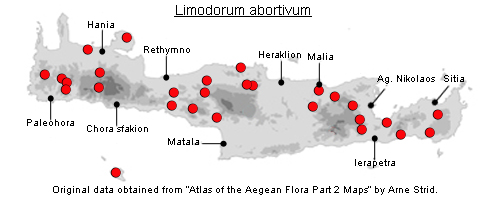SPECIES DESCRIPTION
LIMODORUM ABORTIVUM
Family:- ORCHIDACEAE
Common Names:- Violet limodore, Violet birdsnest.
Synonyms:- Jonorchis abortivum
Meaning:- Limodorum. Meaning unknown.
Abortivum (L) Miscarried, with missing or malformed parts.
General description:- Medium to tall, often rather stout, violet-tinged,
Rhizome:- Densely covered with thickish roots.
Stems:- 40-80 cm, erect, robust, rigid; scales numerous, no green leaves.
Leaves:- Without chlorophyll, reduced to numerous sheathing dark purple scales.
Large purplish bracts, lengthened to oval, acute.
Flower:- Rather large, 38-46 mm across, violet; sepals and petals spreading,
pointed, the petals slightly smaller; lip 14-17 mm long, yellowish stained with violet,
unlobed and with a short spur, to 15 mm long, at the base.
Fruit:- Tough and membranous capsules.
Key features:-
Habitat:- Coniferous and deciduous woodland, occasionally scrubland vegetation.
0-1100 m.
Distribution:- Throughout Greece. - Widespread in C Europe and the
Mediterranean region, also through Anatolia to Caucasus and N & W Iran. Sparsely
scattered across Crete, but lacking in the central region.
Flowering time:- Mid-Apr to mid-July.
Photos by:- Steve Lenton
FAMILY AND GENUS DESCRIPTIONS
ORCHIDACEAE
General description:- Perennial herbs with rhizomes, vertical stock or tuberous
roots, terrestrial, sometimes obtaining nutrition from decaying matter (saprophytic),
usually with symbiotic fungi in or on the roots (mycorrhiza).
Stems:- Sometimes swollen at base to form pseudobulbs.
Leaves:- Entire, spirally arranged or in two opposite rows, one on each side of the
stem (distichous), rarely subopposite, reduced to scales or sheaths in saprophytes.
Flowers:- Inflorescence a spike or raceme. Flowers zygomorphic, the sepals,
petals and stamens apparently inserted higher than the ovary (epigynous), usually
hermaphrodite. Perianth-segments 6, in 2 whorls; median inner segment (labellum)
usually larger and of different shape from the others, usually directed downwards
owing to the ovary or the stem (pedicel) twisting through 180°, often with basal spur.
Anthers and stigma borne on a column formed from fused filaments and style;
stamens 1, rarely 2, with stalkless (sessile) or short-stalked (subsessile), 2-celled
(2-locular) anthers behind or at the summit of the column; pollen-grains single or in
tetrads, bound by elastic threads in packets (pollinia) which may be narrowed into a
sterile, stalk-like caudicle. Ovary inferior, 1-locular, with parietal placentation, rarely
3-locular; stigmas 3, all fertile, or with the median sterile and often consisting of a
beak-like process (rostellum) between the anthers and fertile stigmas; rostellum
often forming 1 or 2 viscid bodies (viscidia) to which the pollinia are attached;
viscidia sometimes enclosed in 1(2), simple or 2-lobed, membranous, pocket-like
outgrowths (bursicles) of the rostellum.
Fruit:- A capsule, splitting open to release the seeds (dehiscing) by 3 or 6
longitudinal slits; seeds numerous, minute, with undifferentiated embryo and no
endosperm.
LIMODORUM
General description:- Violet saprophytes (plants without chlorophyll which live on
humus) with short rhizome.
Stem:- Clothed with scale-like sheaths. Green leaves absent.
Flowers:- In an erect, spike-like raceme. Perianth-segments free, patent. Labellum
entire. Spur long, slender, curved upwards. Column long. Viscidium solitary;
bursicles absent.
Key features:-
1) Plant without green leaves
2) Spur long, slender
3) Labellum entire, directed downwards.
